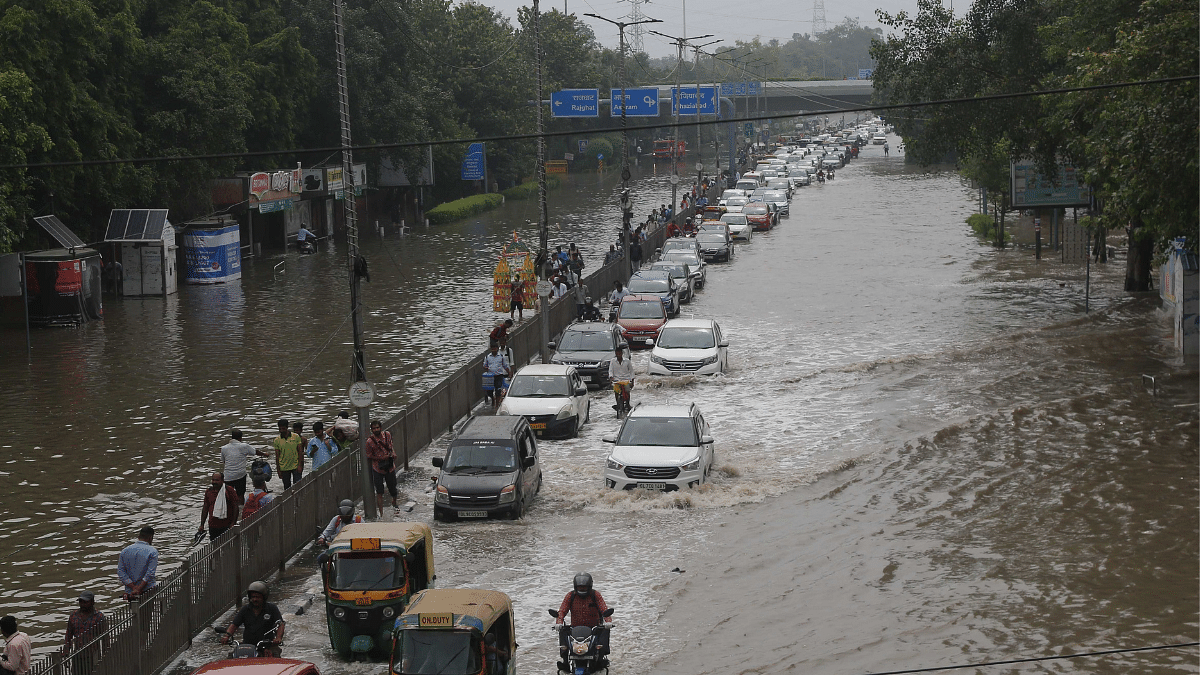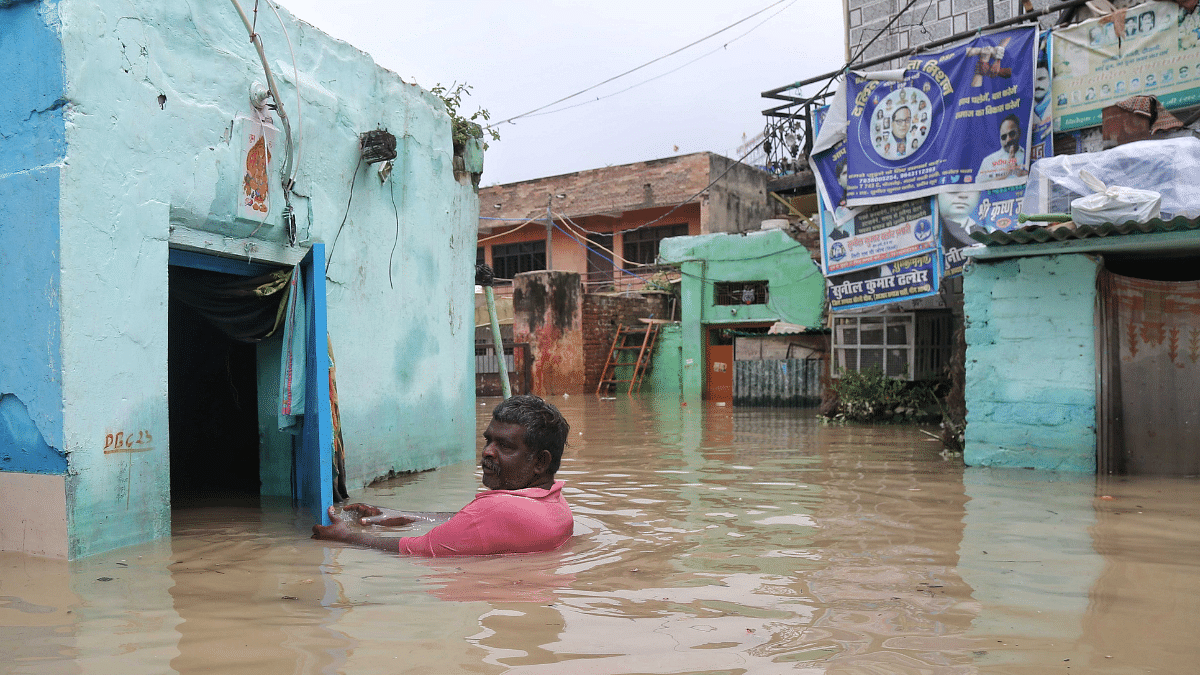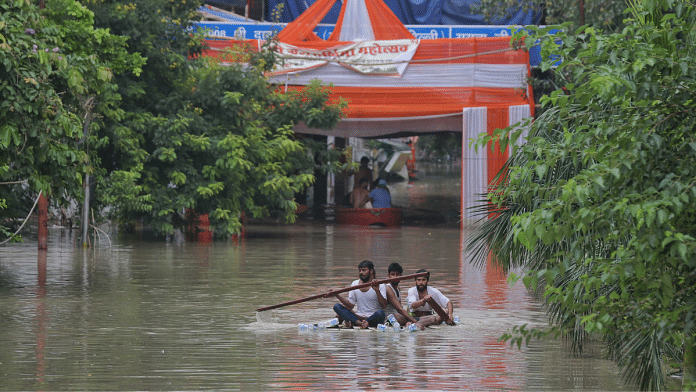New Delhi: Heavy rains and water release from the Hathnikund barrage in Haryana were not the only reasons for the severe flooding that hit parts of north and east Delhi last week. The chaos that gripped the city was also a result of Delhi’s crumbling infrastructure, lax enforcement against encroachment, especially on the floodplains, and a blamegame among states.
The affected areas in the city included upscale neighbourhoods like Civil Lines, slum clusters of Yamuna Pushta, heritage sites like Red Fort and Rajghat, and busy commercial zones on Ring Road and ITO.

The flooding in parts of ITO and Ring Road, one of the thoroughfares of the capital, after five sluice gates of the ITO barrage near Ring Road got jammed and stopped working Friday was a result of negligence and unaccountability on the part of different authorities responsible for its upkeep and maintenance.
There are three barrages — a structure across a water body with sluice gates to control the flow of water through them — on the Yamuna after it enters Delhi.
The Wazirabad barrage, which is maintained by the Delhi government, the ITO barrage, which is maintained by the Haryana government, and the Okhla barrage, maintained by the Uttar Pradesh government.
The ITO barrage has 32 gates. When there is heavy flow of flood water, all the gates of the barrage are opened and water is discharged through them.
Senior officials of Delhi’s flood and irrigation department told ThePrint that, last week, when the level of Yamuna rose (because of floods in Himachal Pradesh and Uttarakhand), approximately one to three lakh cusecs of water was discharged from the Hathnikund barrage to Delhi on 12 July for most part of the day, with a peak discharge of 3.59 lakh cusecs at 11 am.
While all the gates of the Wazirabad barrage were opened, five of the 32 gates of the ITO barrage were not functioning as they were clogged because of accumulation of heavy silt and sewage at the bottom, the officials added.
Had the gates been opened, the water coming from Wazirabad would have got discharged through them towards the Okhla barrage and from there flowed towards UP, the officials said.
“Because the gates were clogged and water could not be discharged, the level of water coming from behind increased and there was a backflow, resulting in flooding of the adjoining areas,” a senior Delhi flood and irrigation department official told ThePrint.
To open the five gates, the Delhi government sought the help of Army and Navy divers. According to a statement issued by the Indian Army on 13 July, a team of engineers was employed to cut the overhang above the sluice gates.
The Delhi government official said the Navy team had to extract silt from 10 feet under the water, while the Army’s team of engineers pulled one of the clogged gates with a crane.
The official added that it is a standard operating procedure to open all the barrage gates whenever there is a heavy discharge of water because of rains/flood.
“When water was discharged from Hathnikund barrage, all the gates of Wazirabad and Okhla barrage were opened, but not all at ITO,” said the official, who did not want to be named.
By the time this report was published Monday afternoon, only one of the five clogged gates at the ITO barrage had been opened. The other 27 gates were functional.
Also Read: In the same boat, yet not — surviving the Delhi floods, a tale of two localities
ITO barrage: With Haryana or not?
But why did the five gates of the ITO barrage get clogged in the first place?
According to a senior engineer of the Haryana irrigation department, who did not wish to be named, the ITO barrage was built by Punjab in the 1960s — when Haryana was still part of Punjab — to provide water to two thermal units of Indraprastha Power Generation Company Limited’s (IPGCL). The water served as a coolant for the turbines.
“Since Delhi wasn’t a separate state (did not have its own government) at that time, the task to build the ITO barrage was assigned to Punjab. After Haryana was carved out in 1966, maintenance of the ITO barrage was given to it. The money for the maintenance of the barrage was initially paid by Indraprastha power plant,” the engineer said.

But the plant was shut in the 2000s following an order of the National Green Tribunal.
“When the Rajghat power plant was also shut in 2015, IPGCL, which operated these two units, continued paying the maintenance charge till 2019. However, since 2019, no money has been paid for the maintenance of the plants by the IPGCL or the Delhi government,” the engineer added.
Responding to Haryana government’s allegation that neither IPGCL nor Delhi government has paid paid for the maintenance of the plants since 2019, a Delhi government spokesperson said, “The thermal power plants had an agreement with Haryana government for which they used to pay for using water from ITO barrage. But these plants were decommissioned in 2009 and had no reason to pay anymore. The IPGCL also stopped using water from ITO barrage, instead it used water from Delhi Gate STP of DJB. Haryana government is aware of these facts and were informed about this four years back.”
The Delhi government flood and irrigation department official quoted earlier also said that, as of now, nobody is paying for the maintenance of the ITO barrage.
“Structures like barrages have to be regularly maintained. Because they are made of steel, there are chances of them getting rusty. They have to be painted annually, the sluice gates have to be checked to see they are functioning. None of this was done,” the official added.
ThePrint has reached the Delhi government spokesperson over WhatApp for clarity on the barrage’s maintenance and the payment for it. This report will be updated when a response is received.
A political blamegame has already started over the issue.
While Delhi Chief Minister Arvind Kejriwal blamed Haryana for the clogging of the five gates of the ITO barrage last week, his counterpart in Haryana, Manohar Lal Khattar, Sunday said the Delhi government had never informed that such a problem (flooding because of clogged gates) could arise.
“The Delhi government never held a flood-control meeting, and if they did, they never talked about the stoppage of funds for maintenance of the ITO barrage to Haryana. Today, when there is a problem, they are creating an unnecessary ruckus,” Khattar said at a press conference.
Hitting back at Khattar, the Aam Aadmi Party (AAP)-led Delhi government said it has repeatedly requested the Haryana government to transfer the barrage to it, and also flagged the issue of lack of maintenance of the barrage.
Showing multiple letters written by the Delhi government to Haryana regarding ITO barrage and non-functional gates, Delhi Irrigation and Flood Control Minister Saurabh Bharadwaj said at a press conference Sunday, “The official correspondence from Delhi clearly explained to Haryana the critical link between the Hathnikund barrage’s water levels and potential flooding in Delhi.”
“We proposed a solution that either Haryana should transfer the barrage’s ownership to Delhi government or take action to open its gates. These official letters serve as a testament to our sincere efforts to resolve this matter through dialogue and cooperation. However, despite repeated appeals, the Haryana government has failed to acknowledge the severity of the issue and take necessary action,” Bharadwaj added.
Meanwhile, officials at the Delhi lieutenant governor’s office Sunday said the apex committee on flood preparation, which is headed by Delhi CM Arvind Kejriwal, had not met in the past two years. The committee comprises all ministers, Delhi MPs, nominated MLAs, Delhi chief secretary and heads of the departments concerned.
Double whammy
Along with the clogging of the sluice gates at ITO, the damage to the regulator door near the WHO building around 7 pm Thursday because of high water pressure compounded the flooding in areas near the Supreme Court and Mathura Road. These areas have never seen flooding before.
The Army was pressed into service. On Sunday evening too, the irrigation and the flood control department were carrying out repair of the door.
“The door got damaged due to the high volume of water in the river,” said a second official with Delhi government’s irrigation and flood control department.
An Army statement issued Friday said that, at this location (near WHO building), backflow of water from the Yamuna river started flooding the city as the regulator door was damaged due to the surge of water from Yamuna river.
“The engineer team assessed the situation and constructed a temporary bund to divert the water back to Yamuna river. The backflow of water into the city has been controlled. The engineer team of the Army is deployed at the location and prepared to handle any situation,” the statement said.
Encroachment of the floodplain
Speaking to ThePrint, senior Delhi government officials said that it’s an undisputed fact that the capital witnessed unprecedented rains on two days last week. Along with the discharge from the Hathnikund barrage, this resulted in the water level in the river breaching the danger mark of 205.33m, they added.
“The water level reached a record of 208.66 metres. The previous highest was 207.49 metres in 1978,” another senior Delhi government official told ThePrint, adding that even Sunday evening (8 pm), the water level was above the danger level at 205.56m and several parts of the city were still flooded.
When asked about the reason for flooding in the Civil Lines areas, a senior irrigation and flood control official said that it was a low-lying area.
“The minimum height of the embankment is around 208m. But when water level has breached the highest flood level, then flooding is bound to happen, especially in low-lying areas. There was backflow in drains, which couldn’t discharge in the river due to high water level,” said the senior official with Delhi’s irrigation and flood control department.
“The flooding this time has shown that we need to re-strategise and also clear the floodplain of any encroachment. The river water has to have space to flow. The encroachments constrict the water’s route resulting in backflow and flooding,” the official added.
On 13 July, senior AAP leaders had alleged that no water was released into the Western Yamuna Canal and Eastern Yamuna Canal and it was released to flow towards Delhi in Yamuna. Delhi Jal Board vice-chairman Somnath Bharti had said that “no water was released towards Uttar Pradesh or Haryana through the canals”.
However, Haryana has refuted these charges. Haryana CM adviser (Irrigation) Devender Singh, in a press note Friday, said,“According to CWC [Central Water Commission] guidelines, if the inflow of water in Hathnikund barrage is more than 1 lakh cusecs, then the flow of this water cannot be diverted to the Western Yamuna Canal (which includes Haryana’s share of Yamuna water) and Eastern Yamuna Canal (which flows towards UP) due to large boulders that could damage the barrage structures
“In such a situation, the head regulator gates of the canals are closed and the gates of the cross regulator on the barrage are opened for free flow of water into Yamuna river.”
(Edited by Richa Mishra)



